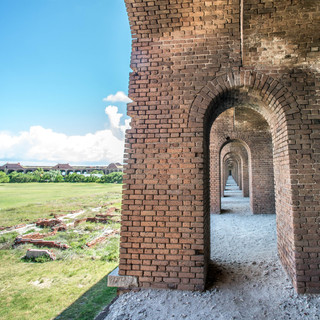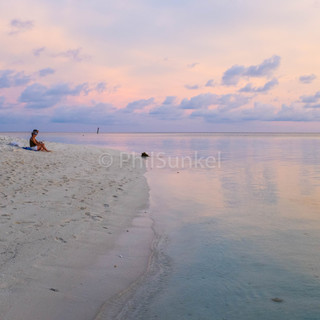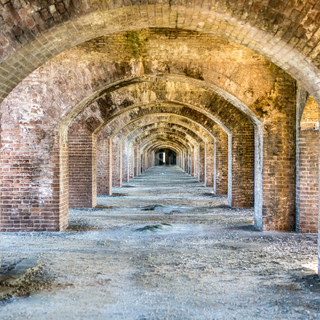The Dry Tortugas: Totally Worth It
- Phil
- Sep 23, 2016
- 9 min read

As the sun rises, making its way above the salty horizon line in the lower Florida Keys, I pack my bags and load my kayak onto my Ford F150's A.R.E. Topper, as I begin my quest to the Dry Tortugas.
The drive through Key West at the crack of dawn is painless, unlike during the day or at night. Long-term parking for the Dry Tortugas ferry is located in a parking garage on Grinnell street just a block away from where the ferry departs. A word of advice, do not park at the parking garage across the street from the ferry if you are planning on camping on the island. You will get towed!
The Yankee Freedom III sits docked at the Key West Ferry Terminal at 100 Grinnell street as campers begin to load their gear onto the ferry around 6:30 am. The cost of the trip for one person is $170 for the ferry ride, $20 for camping and another $20 to bring a kayak with you, which comes to a grand total of around $210 per person. From everything I’ve been told by locals in the keys and friends who have been out to the islands, the price is well worth the experience.

The task of loading all of your gear onto the ferry is actually quite simple. As mentioned above, you can pull your car pretty much right up to the ferry. You can then select one of many of the yacht wagons they have located at the terminal to bring your and your families gear up to the ferry. Shortly after loading up you will have a quick sit down with the ship's captain who will give you the low-down on everything you will need to know.
Don't worry about overpacking too much. I ended up under packing, next time I will bring at least four battery powered fans with me. It was extremely hot out on the island.
Those who simply just can't wait to get out there and want a quicker trip out, can take a seaplane for $299 per person for a half-day excursion or $525 for a full-day. The flight only takes 40 minutes from Key West and I’m told the views are breathtaking.

If you have your own yacht though, your in luck. Mooring is free and only requires a boat permit, which can be obtained at the Ranger’s office within historic Fort Jefferson. Visiting boats are allowed to stay up to 14 days.
As the state-of-the-art ferry departs Key West around 7:30 a.m. on its two-and-a-half hour trip out to the islands, my mind can't help but to plow through the stockpile of history surrounding the Dry Tortugas.
The islands were first discovered by none other than Ponce De Leon in 1513, De Leon is also credited with the first landing in St. Augustine, Fl in April of that same year.

De Leon decided to name the islands “Las Tortugas” which is Spanish for turtles, in honor of the large population of turtles surrounding the islands. He also ate plenty of those said turtles, as did his crew.
Years later, “Dry” was added to the name “Tortugas” to warn mariners that the land contained no freshwater, which was and still is mighty important to seafaring folk.
Sitting out in the open air on a solid plastic bench atop the massive catamaran, the smell of the salt breeze ignites my senses as my mind begins to register the fact that we are getting pretty far out to sea. Soon, Ill be walking upon the shores of the impenetrable Fort Jefferson, fondly known to visitors and locals alike as “Fort Jeff”.

The first structure built on Garden Key, was not Fort Jeff, but rather the Garden Key Lighthouse, which was erected in 1825 to help prevent shipwrecks. Unfortunately, the lighthouse was not much help to ships and their crew. Today, there are hundreds of shipwrecks littering the reefs around Fort Jeff making it one of the highest concentrations of wrecks in the United States, which also makes it ripe for scuba diving and snorkeling adventures.
According to DryTortugas.com, “After the War of 1812 a group of forts from Maine to Texas was envisioned to provide defense for the United States of America. Fort Jefferson was built to protect the southern coastline of the United States and the lifeline of commerce to and from the Mississippi River. The fort was planned to be the greatest of these.”
To put it simply, the main purpose of Fort Jeff was to act as an advance post to help supply ships patrolling the Gulf of Mexico and Straights of Florida. The placement of the Dry Tortugas, within some of the world’s busiest shipping lanes, made the fort one of the military’s greatest assets at the time. In reality though, the fort served as a prison for rebel soldiers of the Confederacy.

Construction on the Fort began in 1846. However, almost immediately, Engineers noticed that the massive fortress was sinking into the earth due to its extreme weight, as a result, much of the second floor was left unfinished.
At the height of the Fort’s use, the complex held around 2,000 soldiers, their families and the prisoners being held on the island.
The most famous prisoners on the island were four of the accused Lincoln assassination conspirators, one of those prisoners being the semi-innocent Dr. Samuel Mudd who set the broken leg of Abraham Lincoln’s Assassin, John Wilkes Booth, who came to Dr. Mudd in disguise after breaking his leg jumping to the stage from the balcony after murdering the president.
During a yellow fever outbreak on Garden Key, Dr. Mudd earned his freedom around the island by caring for the sick alongside Dr. Daniel Whitehurst ,after the fort surgeon and nurses succumbed to the fever and died.

Mudd famously once said about his time consoling the sick on the island, “I could do more by a few consoling inspiring words, than with all the medicine known to me.”
Years later, Mudd’s wife petitioned President Andrew Johnson, who eventually released Mudd with a presidential pardon.
As my mind continues to drift through the amazing history of Fort Jeff and its former inhabitants, I realize we are finally pulling up to the dock at Garden Key.
With my own eyes, I can now see why naturalist John Audobahn and writer Ernest Hemingway were so drawn to the place.
First of all, the Dry Tortugas are an outdoors lovers dream. From endless bird watching, to incredible fishing, to some of the best snorkeling in the U.S.; these 100-square miles are without a doubt, a national treasure.

Second, the history is literally overwhelming. You can feel it the moment you set foot on Garden Key. From Dr. Mudd’s cell, to the incredible structural engineering designed for one of the Army Corp of Engineers first Sub-Marine construction projects. The islands are a treasure trove for history hunters.
As I made my way off the Ferry, past the huge mass that is the Fort and into the campgrounds along the beach, I couldn’t help but overhear a naval NFO talk about his training in F18’s on Boca Chica Key for the past three weeks. I pulled him aside and asked him what he thought of the island so far.
“Its’ great here. I'm down here for training and had a Saturday off, so I figured I’d come on down to the Dry Tortugas,” said Jason Slagle, 34, I had heard many good things, so I’m pretty excited to be here.”

The campsites on Garden Key are pretty large, they all have a picnic table, a charcoal grill and an amazing view. About half of the campsites had excellent shade to keep the brutal sunshine at bay. If you stay more than one night, a good strategy is to wait for other campers to leave and then take there spot, but only if it is better than yours of course.
The best part though? The beach is a total of ten steps from the front of where your tent will be situated.
Once I had my gear all setup, I sprinted into the crystal clear water which surrounds the island. The fort is bordered by a giant moat wall, which is occasionally inhabited by an elderly docile crocodile who Park Rangers believe was washed there in a storm. All along the moat, beautiful coral structures abound with thousands of spectacularly colored fish. Don't worry about forgetting the mask and snorkel at home. Both the ferry and seaplanes include mask and snorkel rents in their rates.

Another fun fact about the water surrounding this place, almost the entirety of the Dry Tortugas National Park is fishing-free. The only place you can throw a line in, happens to be a one-mile radius around Garden Key. Because of this, the snorkeling is incredible and the fishing is even better.
Henry and David Hall came down to the park from their respective homes in Vermont and Boston for a four-day father and son camping and fishing trip.
“The fishing here is fantastic and the catching is even better.” Said Henry Hall, 67, “David caught most of the fish, I was doing more of the rigging of the lines.”
The Hall's ended up having a bunch of luck out on their rented tandem kayak.
David told me that he caught “An 11 lb. Grouper, a Barracuda, a big Hound fish, they were jumping all over into the air and last but not least we got a yellow-tailed Snapper.”
Aside from the fishing, snorkeling, kayaking, and swimming, there are hours of exploring to be had within Fort Jefferson's labyrinth of corridors.

The interior casemates of the fort, run almost a full mile. Some of the corridors create an illusion of almost infinite depth. The entire fort is filled with helpful signs describing the old fort’s varied history, including tidbits about Cuban refugees landing on the island.
By far the most interesting aspect of the fort is how the structure has been kept very natural, rather than modernized like other National Park sites.
“To some extent, the fort is a lot like it was when it was being used during the Civil War.” Said Bryan Mclean, 32, of Washington D.C. “All the windows have been left open, the lighthouse is still intact, but of course a ton of the cannons are missing.”
Even with some of the cannons missing, the cool (literally) nooks and crannies within the fortress, will keep you busy exploring for a good couple of hours.
After I explored the fort for a bit, I hit the water on my kayak to escape the crowds that throng to the island from the ferry to hurriedly try and explore the fort in their allotted four-hour time slot.

Instant gratification washes over me as the hustle and bustle of the people on the island simply fade away.
With 99% of the Dry Tortugas National Park being underwater, the seven small islands which exist in the park only represent the other 1%, the best way to see the park is obviously from a boat or under the water.
After washing up onto the shore and parking my kayak on what is called dinghy beach, I wait for the sun to set and the stars to rise.
When darkness fell, a heavy squall blew in drenching the campgrounds for a good long while.
At Around 2:30 a.m., I prodded myself out of bed to take a look at the sky to see if the storm had cleared up. The skies were clear.The Milky Way gleaming just overhead.

I am now fully convinced that Garden Key may be the best spot East of the Colorado Rockies for star gazing.
The next morning I spent the majority of my time relaxing in the sparkling water. Even though there were probably about 20 other people camping on the island, I had the beach totally to myself. No sign of another living soul. Just myself and endless ocean.
Once the Ferry arrived with the masses, I made my way through the fort to a picturesque gun port overlooking the channel leading out to Loggerhead Key.
To pass the time until I left on the ferry with the crowd that afternoon, I read Hemingway’s Pulitzer Prize winning classic, “The Old Man and The Sea”. I finished the short story in a couple hours and I went on to think about the times when Hemingway had been to Garden Key.

In fact, at one point he and his “mob” as they called themselves, were marooned on the island for 17 days due to inclement weather. Apparently it was no big deal, since history has it that they had enough food and booze to last them those 17 days. If only Hemingway had written a tale about that adventure, it sure would have been quite colorful.
As I made my way back to the Ferry from the Ramparts which sit atop the fort, I cant help but think “Will I ever be here again?” Will I ever get to walk down these amazing breezy brick corridors another time? Will there ever be another moment in my life when I will get to swim in water as pure and clear?
Just as Hemingway returned to those seven small islands several more times after being shipwrecked here, I now too feel entranced with the inert reaction to visit again. Hopefully as soon as possible.
The Dry Tortugas is paradise found. It may have once been known as Devil's Island but history combined with outdoor adventures of the highest quality make this national park one of the most incredible and unique in the United Stares, not to mention one of the most difficult to reach.
Photos and article by Phil Sunkel
**Editor's note: This article originally appeared in Vero Beach 32963.







































































